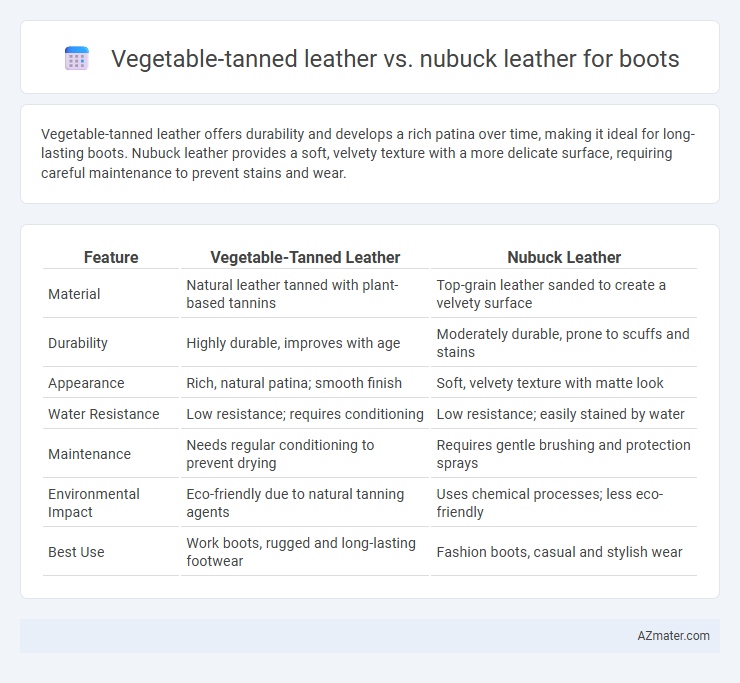Vegetable-tanned leather offers durability and develops a rich patina over time, making it ideal for long-lasting boots. Nubuck leather provides a soft, velvety texture with a more delicate surface, requiring careful maintenance to prevent stains and wear.
Table of Comparison
| Feature | Vegetable-Tanned Leather | Nubuck Leather |
|---|---|---|
| Material | Natural leather tanned with plant-based tannins | Top-grain leather sanded to create a velvety surface |
| Durability | Highly durable, improves with age | Moderately durable, prone to scuffs and stains |
| Appearance | Rich, natural patina; smooth finish | Soft, velvety texture with matte look |
| Water Resistance | Low resistance; requires conditioning | Low resistance; easily stained by water |
| Maintenance | Needs regular conditioning to prevent drying | Requires gentle brushing and protection sprays |
| Environmental Impact | Eco-friendly due to natural tanning agents | Uses chemical processes; less eco-friendly |
| Best Use | Work boots, rugged and long-lasting footwear | Fashion boots, casual and stylish wear |
Introduction: Understanding Boot Leather Types
Vegetable-tanned leather offers durability and develops a rich patina over time, making it ideal for boots that age gracefully with use. Nubuck leather, sanded on the grain side, provides a soft, velvety texture with a unique appearance but requires more careful maintenance due to its delicate surface. Selecting between vegetable-tanned and nubuck boot leather depends on the desired balance of toughness, aesthetic, and care requirements.
What is Vegetable-Tanned Leather?
Vegetable-tanned leather is crafted using natural tannins from tree bark and plant extracts, resulting in a durable and environmentally friendly material ideal for boots. This type of leather develops a rich patina over time, enhancing its aesthetic appeal and aging gracefully with use. Unlike nubuck leather, vegetable-tanned leather maintains a firmer texture and is more resistant to moisture and scratches, making it a practical choice for rugged footwear.
What is Nubuck Leather?
Nubuck leather is a top-grain cattle hide that has been sanded or buffed on the grain side to create a slight nap of short protein fibers, giving it a velvet-like surface and a soft, luxurious feel. Unlike vegetable-tanned leather, which is treated with natural tannins from plant materials, nubuck is typically chrome-tanned, making it more flexible and resistant to water but requiring more care to prevent staining. Nubuck is prized for its rich texture and durability in boots but demands regular cleaning and protective treatments to maintain its appearance and longevity.
Durability: Veg-Tan vs Nubuck Boots
Vegetable-tanned leather boots offer superior durability due to their dense fiber structure, making them more resistant to wear, scratches, and water damage compared to nubuck boots. Nubuck leather, characterized by its soft, sanded surface, tends to show scuffs and stains more easily and requires regular maintenance to preserve its appearance and longevity. For tough, long-lasting footwear, vegetable-tanned leather provides better resilience and aging qualities suitable for heavy use.
Comfort and Flexibility Comparison
Vegetable-tanned leather offers superior breathability and molds naturally to the foot, enhancing comfort over time with increased flexibility. Nubuck leather, sanded on the grain side, provides a soft, velvety texture that initially feels flexible but may require break-in to achieve optimal comfort. Both leathers improve in flexibility with wear, but vegetable-tanned leather generally adapts more quickly to individual foot contours, making it ideal for extended wear in boots.
Water Resistance: Which Leather Excels?
Vegetable-tanned leather offers superior water resistance compared to nubuck leather, as its dense fiber structure and natural tannins provide enhanced moisture repellency without heavy chemical treatments. Nubuck leather, despite its soft, suede-like finish, tends to absorb water more readily due to its buffed grain surface, making it more susceptible to water damage and staining. For boots requiring durability in wet conditions, vegetable-tanned leather is the preferred choice due to its inherent water-resistant properties and ability to improve with proper conditioning.
Appearance and Aging: Patina vs Texture
Vegetable-tanned leather develops a rich, dark patina over time, enhancing its natural character and showcasing variations that reflect the wearer's lifestyle, making each boot unique. Nubuck leather features a soft, velvety texture with a matte finish, which subtly changes with wear through slight darkening and smoothing but lacks the pronounced patina seen in vegetable-tanned leather. Both leathers age attractively; vegetable-tanned boots emphasize color depth and shine, while nubuck boots highlight an evolving tactile texture.
Maintenance and Care Requirements
Vegetable-tanned leather requires regular conditioning to prevent drying and cracking, as it is more prone to absorbing moisture and stains due to its natural tanning process. Nubuck leather, being sanded on the grain side, demands consistent brushing with a nubuck brush and use of protective sprays to maintain its soft, velvety texture and resist water damage. Both types benefit from avoiding prolonged exposure to direct sunlight and water, but vegetable-tanned leather typically needs more frequent conditioning treatments to preserve its durability.
Environmental Impact of Leather Choices
Vegetable-tanned leather uses natural tannins from tree bark and plant extracts, making it biodegradable and less harmful to ecosystems compared to chrome-tanned Nubuck leather, which relies on heavy metals like chromium that can pollute waterways. Nubuck leather undergoes extensive sanding and buffing, increasing waste and chemical use during production, whereas vegetable tanning processes are generally more sustainable with lower energy consumption. Choosing vegetable-tanned leather for boots supports a reduced environmental footprint by minimizing toxic waste and encouraging biodegradability in leather products.
Which Leather is Best for Boots?
Vegetable-tanned leather offers superior durability and develops a rich patina over time, making it ideal for rugged boots that require long-lasting wear and ease of maintenance. Nubuck leather provides a softer, more luxurious texture with a velvety finish but demands more careful handling to avoid stains and water damage, suitable for fashion-forward or casual boots. For heavy-duty, everyday boots, vegetable-tanned leather is the best choice due to its toughness and ability to mold to the foot, whereas nubuck excels in style-focused footwear.

Infographic: Vegetable-tanned leather vs Nubuck leather for Boot
 azmater.com
azmater.com